🎹 UPDATED REVIEW – October 25, 2019 – Roland HP603, HP605, LX7, LX17, GP607 Digital Pianos – Recommended – In the competitive world of digital pianos, the top digital manufacturers such as Yamaha, Roland, Kawai, Casio, and others are always trying to compete for having the best pianos at the most reasonable prices…and they all do a good job of that. Digital piano technology is getting more realistic and exiting each time a new model comes out and these top manufacturers all have great products,
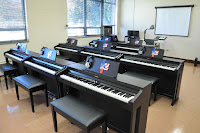 |
| University Roland digital piano lab |
although there are some models that are better than others in trying to reproduce a great acoustic piano playing experience in a digital piano, in my opinion. So when the Roland company comes out with new piano products, people that know and play music are usually impressed. After all, Roland is not only known for building some great digital upright & grand pianos for beginners through accomplished pianists with their pianos being found on stage, in famous Universities, in recording studios, churches, schools, and other venues, but Roland also builds other types of music products too.
UPDATED INFO – After more than 3 years of being current models, Roland has discontinued this entire line of digital pianos with the exception of the GP607 and GP609 grand pianos.
When Roland introduced their line of HP & LX digital pianos a few years ago, many people thought these instruments would likely be a rehash of previous HP/LX piano technology that came out previously but with a few minor changes and upgrades and that Roland would just go about business as usual. Well…after I got through playing all the Roland pianos including the HP603 (and HP603A with BT audio) in black or rosewood satin finishes ($3199US retail price), HP605 in black or rosewood satin finishes ($3899US retail price) and in polished ebony ($4499US retail price), LX7 in custom walnut or black satin finishes ($5699US retail price) and in polished ebony ($6299US retail price), the top of the line vertical upright piano LX17 in either
polished ebony or polished white finish ($6999US retail price), and the mini grand piano 37″ deep GP607 in polished ebony or polished white ($6999US retail price). I can tell you that Roland has entered into a new dimension of piano sound technology as well as designing a new key action and new internal speaker systems, and even some new cabinet designs and finishes that exceeded what I had expected from them. Even the popular satin rosewood finish has been redone from previous models and upgraded to look a bit more natural with more wood grain and color, although it’s not real wood:). In other

words, these newer Roland pianos impressed me with what I considered to be a more natural piano playing experience than I have had on a Roland piano previous to this, and I have played them all. This does not mean a person (including myself) cannot enjoy playing on the other major brands of digital pianos because you certainly can enjoy them. But what it does mean is that Roland is trying to recreate a real acoustic piano playing experience in a different way given the available technology, and there are some things I like very much about it and some things I do not like as much. It is important for me to note that the new HP, LX, and GP models are not available for purchase on the internet in the US. You can only find them in local piano stores that carry these models and you may or may not have a Roland store near you. If you are in the US and want more info on this please let me know.
| LX7 satin walnut |
So what is the difference between these Roland models over the previous Roland models as well as compared to their their competition from Yamaha and Kawai? To start off, for the first time Roland has created a hybrid key action unlike anything they have done before. Each key consists of a combination of wood and plastic (instead of all plastic in the previous Roland models) and Roland claims this gives the key movement more authenticity and natural weight as well as eliminates maintenance of all wood actions. Roland’s claim is that these new keys give the key structure more durability and more rigidity (with the addition of an inner stabilizer pin which also reduces lateral key movement) while allowing the action to feel more authentic with the wood in the keys to vibrate a bit from the sound waves when the “digital strings” are vibrating, as a key would normally do in a real acoustic piano. In other words, the
Roland’s claim is that these new keys give the key structure more durability and more rigidity (with the addition of an inner stabilizer pin which also reduces lateral key movement) while allowing the action to feel more authentic with the wood in the keys to vibrate a bit from the sound waves when the “digital strings” are vibrating, as a key would normally do in a real acoustic piano. In other words, the 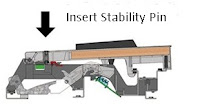
key is not all plastic and not all wood as you would normally find in the other popular digital piano brands and Roland would claim this is the best way to produce a key in a digital piano. I personally don’t know if it’s the best way to make a key and I doubt that the small amount of wood in the key does too much other than look nice, but as long as the keys move smoothly, are balanced well, and are graded weighted in a satisfying way, then that’s what I look for, and I believe this new key action called the PHA50 does all that. It is an upgrade to the previous top of the line key action called the “Concert Action” which Roland had in their previous HP506, HP508, LX15e. HPi50e, and DP90Se. Although I always felt that the Concert Key Action was very good and enjoyable to play, this new PHA50 action is even more so and I did notice some advantages.
| HP603 Rosewood |
It is definitely worth mentioning that the new top-of-the-line PHA-50 key action is on all of the new Roland models instead of just some of them as they did in past models. This is not the case with Kawai and Yamaha digital pianos where they generally reserve their better key actions for their higher priced models. However, Yamaha’s higher priced (CLP675) digital piano key action is actually not as good in my opinion as the lower priced Yamaha CLP key action called NWX wood key found in their CLP645 piano which retails for about $4000 US. The Roland PHA50 key action is found in all Roland digital pianos starting in the Roland HP603 (and HP603A) for just $3199US retail price on up. 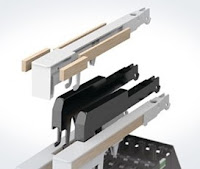 Key actions are a “tricky” thing because what one person may find very good and comfortable to play, another person may have a different opinion. So price alone in a digital piano does not determine quality or realism of key action when compared to a real acoustic piano. I will say that Yamaha has an all-wood complete acoustic upright key action (minus the felt hammers) in a digital piano they call the NU1X and that model sells for approx $6000US at discount. I have played the new NU1X many times and it has a more authentic key action as compared to any of the key actions found in digital pianos under $6000 because that key action is the “real deal” although it is based off an acoustic upright key movement and not an acoustic grand piano. Nevertheless it still feels very nice to play and I like it. The new Roland PHA50 key action moves and feels good but there are no actual moving hammers and other key action parts in the Roland pianos like a real piano has or like the Yamaha NU1X has.
Key actions are a “tricky” thing because what one person may find very good and comfortable to play, another person may have a different opinion. So price alone in a digital piano does not determine quality or realism of key action when compared to a real acoustic piano. I will say that Yamaha has an all-wood complete acoustic upright key action (minus the felt hammers) in a digital piano they call the NU1X and that model sells for approx $6000US at discount. I have played the new NU1X many times and it has a more authentic key action as compared to any of the key actions found in digital pianos under $6000 because that key action is the “real deal” although it is based off an acoustic upright key movement and not an acoustic grand piano. Nevertheless it still feels very nice to play and I like it. The new Roland PHA50 key action moves and feels good but there are no actual moving hammers and other key action parts in the Roland pianos like a real piano has or like the Yamaha NU1X has.
 The Roland key action also has the “escapement feature” which tries to simulates the movement of grand piano keys when you press them down slowly and easily and you feel them slightly hesitate or have a notch or bump that occurs as you press the key down. This type of feeling is a natural occurrence on a real grand piano and helps with key control when playing music legato and slowly.
The Roland key action also has the “escapement feature” which tries to simulates the movement of grand piano keys when you press them down slowly and easily and you feel them slightly hesitate or have a notch or bump that occurs as you press the key down. This type of feeling is a natural occurrence on a real grand piano and helps with key control when playing music legato and slowly.
You can actually feel this “escapement” key action feature in the Roland pianos although it is still a simulation and not exactly like a real grand piano. However in all of the newer Yamaha Clavinova CLP pianos, although Yamaha has added the escapement feature for the first time in these recent models, it feels like it’s not really there. In other words, the escapement feel is so subtle that it’s difficult to feel it at all when playing softly and slowly. This has not been my experience on real acoustic pianos where that “escapement” mechanism experience is much more noticeable and distinct without being overpowering. So just because the feature may be there, it doesn’t mean it’s working well, and in my opinion although the Roland escapement feature is more realistic than the Yamaha, as I mentioned earlier it is still a simulation and not the real thing. Kawai also uses the escapement feature, which they call “let-off” (just another name for the same thing) and the Kawai feature is more pronounced and more similar to Roland in that way.
Another thing I noticed about the new Roland key action was how much more quiet it was as compared with their previous models when the keys are moving up and down. By nature, regular acoustic piano key actions do make some noise when the keys are moving, but because those pianos are always so loud and they don’t have a volume control or headphone jack like digital pianos do, you cannot hear the key action noise when playing the piano. However in a digital piano, when you have the volume somewhere between low to medium level or when you are using headphones, then you can definitely hear the key action moving and noise is more of a concern. I can say for sure that the key action noise level on these new Roland pianos is the lowest that it’s been on any Roland digital piano and has surpassed the previous models for an even lower key movement noise reduction level. The previous models were already pretty good and more most people were satisfied with the fairly low ambient noise level of the moving keys. But the new PHA50 key action has definitely surpassed this and has become quieter and 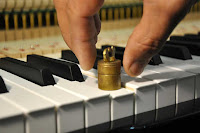
smoother in key movement and this is something that I think many people will appreciate, especially if you play at a higher skill level or you use headphones a lot. Gone are the days on older model Roland key actions when all you could really hear were the “thump” of the keys going down. When you combine this new Roland hybrid key with the quieter, smoother graded-weight (quick response) key movement along with proper key action “down weight” & “up weight” return (measured by actual weights – left pic), you really feel like you can express yourself in a more authentic musically correct way, at least that’s the way that I felt about it when playing these pianos. Then you add the nice escapement feature in the key action along with Roland proprietary synthetic ivory & ebony feel keys (they do feel good), the Roland company has really stepped up to the plate in a big way by improving upon what they already had in the previous models. This key action is not a major breakthrough in my opinion compared to previous models, but I believe that beginners and advanced players will appreciate it very much.

When it comes to piano sound and getting as close to approximating or matching a real acoustic piano, there is no digital piano that can exactly reproduce a real acoustic grand piano sound regardless of what anyone else may say. So the next best thing is “how close can a digital piano get to a real acoustic piano sound playing experience?” If you knew how complex a real acoustic piano sound actually is and what is actually happening in a good grand piano when it comes to the piano sound itself (what it does and how you hear it), you would probably drop your jaw open and think it would be impossible to recreate digitally because there are certain piano sound elements that happen in “real time” that are always changing depending on how fast or slow you play the keys, how hard or soft you hit (play) the
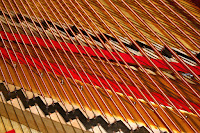
keys, the type of wood the piano is made of, how much soundboard space you have in the real piano, the types of hammers and key felt that is part of the key action, the vibrations and overtones of the 230 strings (give or take) in a real grand piano and how they all interact with each other including the random vibrations, sympathetic noises, frequency changes, tonal dynamics, string thickness, string windings and materials, the scale design, the piano iron frame, dampers and their affect on the sound, decay and sustain time of the sustained strings, volume, duration of the tone and changes in velocity, among other things. Even the the style of music you play such as chording, voicing of chords, staccato and legato of the notes, and the interaction of the string vibrations on the body of the piano all contribute to the final outcome of the sound.

I am a long time piano teacher and pro musician of 40 plus years having taught thousands of students as well as owning, playing on, and teaching acoustic guitar. When it comes to natural grand piano sound, to me that is what it’s all about…beauty, soul, feeling, the piano sound being alive and not digital sounding, and feeling like when you play a song, you can play it may times and every time it comes out a bit differently because a real piano sound is “alive & breathing” and changes, and is not canned, digital, dead, plunky, or without taste or expression. Up until now, Roland, Yamaha, Kawai, and Casio, the four main digital piano companies out there, have been using “sample recording” technology to capture piano sound from a real piano and then put it into the digital micro-processor chip in the digital piano so that it comes out of the speakers and sounds as much like a real piano as possible using that sampling technology.
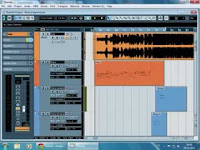
in real time linear playback. But when you play a real piano, the piano sound starts when you first touch the key and hear the sound and then it stops when you let go of the key and pedal. That acoustic piano sound is one straight continuous ever-changing sound in real time. Sampled recording is actually taking a slice or piece of that original piano sound and then is looped in a virtual circle, as I just mentioned, so it plays over & over and is not actually real-time changing linear sound. Picture a hula-hoop going around & around. The hula-hoop is a circle fastened together at a starting & ending point much like a sample recording is done. This is the way piano sound is heard on most digital pianos.
| Previous discontinued HP506 |
Quite honestly, for a large majority of people playing piano these days and regardless of skill level, the piano sampling technology has produced some very enjoyable piano sound in digital pianos and this technology has gotten better and more sophisticated with time, and the end result is some mighty impressive digital piano instruments that have come out from the other brands. Along with increasing sampling sophistication also has come increased polyphony in sampled digital pianos up to 256-notes. This means that when playing a digital piano, if you play complex musical passages using a stereo piano sound, you won’t run out of notes as you play complex music with many keys and sustain at one time along with doing glissando’s, arpeggios, and complex chording, although this is not always the case.
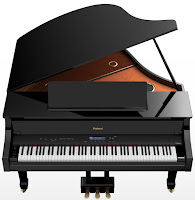
However, Roland has now gone beyond the standard industry piano sound “sampling” technology by introducing a newer sound technology in this $3000-$7500 digital piano furniture cabinet price range called SuperNATURAL piano Modeling. Modeling (aka: modelling) is different from sampling in the way the sound is created and the way you hear it when the piano is being played. Along with this technology being implemented by Roland to create an all new piano sound not found in any other major brand, Roland is putting it in all of their new models instead of just a few at the top of the price range. This means that you can get this new technology of piano sound reproduction starting at around $3000 in their cabinet models. It is typical for digital piano companies to reserve their best features for the most expensive models to get you to spend more
money but Roland did not do this and I commend them for that. So exactly what is SuperNATURAL Modeling technology and what makes it different than other digital pianos? In Sampling technology, the sound elements in a real piano need to be recorded with microphones, as I previously mentioned, and then those recordings need to be translated into computers and then saved in the digital piano sound chips on circuit boards. The recordings can be of a number of different things in a piano including the sound reproduction as you strike a key at different velocities and the noise the hammer makes when it moves, just to name a few. Sampled sounds take a larger amount of computer memory to do it correctly (or as close as can be done), and that may or may not drive up the cost of those instruments. But those sound element recordings never change and cannot “think” on their own such as what real acoustic pianos do in the natural physical world. The technology is also limited by the recording microphones and their ability to get a pure organic sound through the air.
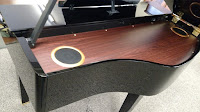
Physical Modeling sound is not recorded from an acoustic piano but is created through non-sampling computer mathematical algorithms. I am definitely not a mathematician so the best explanation I found on the subject which I believe is important to understand (at some level) so that you can appreciate this new piano sound technology, is as follows: “In sound synthesis, physical modeling synthesis refers to methods in which the waveform of the sound to be generated is computed by using a mathematical model or formula, being a set of equations and algorithms to simulate a physical source of sound, usually a musical instrument.
Such a model consists of laws of physics that
govern the sound production, and will typically have several parameters,
some of which are constants that describe the physical materials and
dimensions of the instrument, while others are time-dependent functions
that describe the player’s interaction with it, such as plucking a
string, or covering tone-holes. For example, to model the sound of a drum,
there would be a formula for how striking the drumhead injects energy
into a two dimensional membrane. Thereafter the properties of the
membrane (mass density, stiffness, etc.), its coupling with the
resonance of the cylindrical body of the drum, and the conditions at its
boundaries (a rigid termination to the drum’s body) would describe its
movement over time and thus its generation of sound.” That’s the explanation I found that best suits the technology.
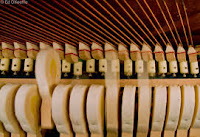
In piano sound physical modeling, that technology is dealing with things such as the energy/force you put into the playing the keys, the interaction of the tonal dynamics, piano hammers, felt movement on the hammers, string movement over time, overtones that excite other moving and non-moving parts of the strings and wood cabinet, and many more physical aspects of a real acoustic piano.,..and all of these physical properties in a real piano are recreated by computer computations. It’s like a powerful computer that draws a “virtual picture” of every aspect of the best
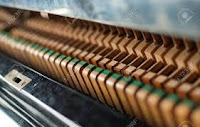
acoustic grand piano possible and then that “virtual picture” instantly comes to life as that actual acoustic piano played instantly in micro seconds with no repetition or sameness. This gives you the feeling that the piano sound which you’re hearing coming through the speaker system is being generated from a real acoustic piano, when in fact is is all done in the virtual technology world. Instead of audio recordings that cannot recreate some of the acoustic organic tendencies and variations that real acoustic pianos 
can project, the physical modeled piano incorporates things like the actual individual staples in each of the felt hammers, the weight of each felt hammer, the speed in micro seconds at which keys move, the vibration rate of each of the 230 piano strings at different key stroke velocities, the wood action parts and the glue, leather, felt, suede, carbon fiber and other material that may be used in real pianos to make things happen. There is no limit to sound recreation using physical modelling technology, but there are limits using the standard sampling technology. Imagine trying to record the vibration sound rates of each string at over 20 velocities across the entire keyboard of strings…it is impossible in the real physical world to do, but it is something that can be done in the virtual world of physical modelling.

 Having 100% physical modeling technology is supposed to give the player an approximation of high quality grand piano sound characteristics without the large size and expense of the acoustic grand piano. With physical modeling technology you can press any one key in the Roland piano by itself without having any additional reverb or sound effects on and that one note will trigger natural occurring overtones for that specific note that you would normally and naturally hear in a real piano. This is something that sampling technology alone cannot do. Having unlimited polyphony (piano processing power) helps make these kind of natural organic elements happen. There is no limit because of the way the sound is generated in the virtual physical world. However, the 256-note polyphony in other name brand pianos is still more than enough to power complex piano music being played a a higher playing skill level. The unlimited polyphony on the Roland pianos is for the acoustic piano sounds but for the non-acoustic piano instruments such as electric pianos, strings, organs, choirs, brass, etc…it’s 384-note polyphony which is also more than the other brands do, but once again, not something that you’ll actually notice when playing these instrumental sounds. Also, polyphony power has little to do with the actual instrument sound quality and the authenticity of those tones. However, when you combine that polyphony power along with a 3-sensor key action, the musical expression and dynamic tonal & volume range you get in these new pianos is impressive. From very soft pianissimo to extra loud forte volume, these new pianos go beyond what a person might otherwise expect out of a digital piano, particularly a Roland digital piano.
Having 100% physical modeling technology is supposed to give the player an approximation of high quality grand piano sound characteristics without the large size and expense of the acoustic grand piano. With physical modeling technology you can press any one key in the Roland piano by itself without having any additional reverb or sound effects on and that one note will trigger natural occurring overtones for that specific note that you would normally and naturally hear in a real piano. This is something that sampling technology alone cannot do. Having unlimited polyphony (piano processing power) helps make these kind of natural organic elements happen. There is no limit because of the way the sound is generated in the virtual physical world. However, the 256-note polyphony in other name brand pianos is still more than enough to power complex piano music being played a a higher playing skill level. The unlimited polyphony on the Roland pianos is for the acoustic piano sounds but for the non-acoustic piano instruments such as electric pianos, strings, organs, choirs, brass, etc…it’s 384-note polyphony which is also more than the other brands do, but once again, not something that you’ll actually notice when playing these instrumental sounds. Also, polyphony power has little to do with the actual instrument sound quality and the authenticity of those tones. However, when you combine that polyphony power along with a 3-sensor key action, the musical expression and dynamic tonal & volume range you get in these new pianos is impressive. From very soft pianissimo to extra loud forte volume, these new pianos go beyond what a person might otherwise expect out of a digital piano, particularly a Roland digital piano.
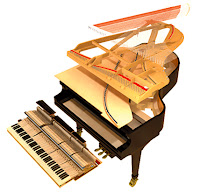 |
| Physical Modeling Virtual Technology |
So when it comes to looking for unfiltered, unadulterated, natural piano sound and expression which is ultimately what everyone wants who is shopping for a good digital piano, at this point in my opinion, Roland’s Physical Modeling technology is giving a person the ability to have a more natural piano playing experience than ever before in a Roland piano. It’s still definitely not “perfect” because after-all, a digital piano is obviously not an acoustic piano, but the Roland HP603, HP605, LX7, LX17, and GP607 gets you closer to feeling like you’re playing an acoustic piano than on previous models. Whether or not YOU can distinguish the difference between a traditional sampled piano sound and the way it behaves when playing a song, and that same song played on a piano with Physical Modelling technology such as what is in these new Roland pianos, that is what really counts. In my opinion many people may have a difficult time in determining (on their own) those differences primarily because most people don’t know what a real piano actually sounds like, or if they do, they don’t play well enough for those differences to really matter.
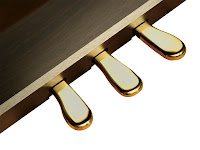
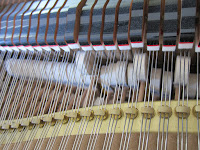 I did want to mention something about pedaling and the fact that without proper pedaling response and reproduction in the sound that occurs from pedaling, especially with the right damper pedal) the playing the piano would not be enjoyable. The right damper pedal is what makes the song sound good and sound correct. It produces the sustain which holds the notes for a duration of times after you play the key(s) while the right pedal is help down. Physically it’s a fairly simple process overall pushing down the pedal and playing the notes, but in reality the process is much more complex as far as what you will hear when doing that. In the world of digital pianos one of the most noticeable things that occurs with the right damper/sustain when holding it down while playing notes is the lack of sustain/decay time, especially on the middle octaves up through the last octave. In other words, the decay time of the notes die off pretty quickly when the sustain pedal is held down and so the song is more choppy and the transitions between notes and chords are not nearly as realistic as they should be. In a real acoustic piano when you press the right damper pedal down, you will not only get long sustain time but also the sustained volume will stay louder and stronger as well as the interaction of the sustained strings sound more complex with noticeable overtones, harmonics, and a variety of vibrations all happening in real time.
I did want to mention something about pedaling and the fact that without proper pedaling response and reproduction in the sound that occurs from pedaling, especially with the right damper pedal) the playing the piano would not be enjoyable. The right damper pedal is what makes the song sound good and sound correct. It produces the sustain which holds the notes for a duration of times after you play the key(s) while the right pedal is help down. Physically it’s a fairly simple process overall pushing down the pedal and playing the notes, but in reality the process is much more complex as far as what you will hear when doing that. In the world of digital pianos one of the most noticeable things that occurs with the right damper/sustain when holding it down while playing notes is the lack of sustain/decay time, especially on the middle octaves up through the last octave. In other words, the decay time of the notes die off pretty quickly when the sustain pedal is held down and so the song is more choppy and the transitions between notes and chords are not nearly as realistic as they should be. In a real acoustic piano when you press the right damper pedal down, you will not only get long sustain time but also the sustained volume will stay louder and stronger as well as the interaction of the sustained strings sound more complex with noticeable overtones, harmonics, and a variety of vibrations all happening in real time.
With regard to all of the fundamental parts of piano playing which I have just talked about including key action, piano sound, and pedaling. if all there was on these pianos were just these parts of a piano and you just turned on the power and started playing, that may be enough for some people. But for other people who enjoy “tweaking” and customizing the sound, feel, and overall piano playing response, Roland has included a huge amount of editing functions for just that very purpose. In fact many of these functions are quite useful and allow people the opportunity of personalizing the playability and piano sound to their particular tastes and playing experience in a number of ways and these features are fairly easy to use although they may be “over-the-top” for some people. But that’s OK because it’s better to have them then to not have them in my opinion. In regular acoustic pianos there are ways that a piano technician-tuner can personalize and customize the piano sound and key action but that can be an expensive process. In the Roland digital pianos this process is in the “digital domain” so it’s free, right at your fingertips by the press of a couple of buttons and you use your ears, fingers, and foot to determine what you like and don’t like. Once you make a change to the overall piano sound you can then save it to a power-up memory. However the piano also has an instant memory feature which saves your changes as you go
without needing to do anything extra…a very cool feature that I have not seen before in pianos like these. If you don’t want those saved changes anymore you can then just reset the piano easily to the factory default settings. Some of the sound editing changes that you can do include Grand Piano Lid height position, Key Off
Noise, Hammer Noise, Duplex Scale adjustment, Full Scale String Resonance, Damper Resonance, Key Off Resonance, Cabinet Resonance, Soundboard Type, Damper Noise, Single Note Tuning, Single Note Volume, Single Note Character, 100 levels of key touch velocity (the way the keys respond to your touch) along with multiple levels of Ambience/Reverb and Brilliance customization. All of the functions and buttons are accessed along the top the keys on the control panel. In my opinion this is the most intuitive and usable placement of controls, display screen, and button placement on a digital piano and Roland is the only brand which offers this kind of setup. Kawai & Yamaha place their controls and display screen to the left of the keyboard which in my opinion and playing experience is much less intuitive and awkward to use and is not in the line of sight.
Ok…so now it’s on to some of the useful digital features and non-piano sounds and functions these new pianos have. The new Roland pianos have 4 Physical Modeled Steinway grand piano sounds including Concert, Ballad, Mellow, and Bright with the ability to edit them in 100’s of ways as I mentioned earlier. It is not the
quantity of individual piano sounds that count but it is the quality. Beyond those physical modeled sounds are the addition of 8 more piano types including upright, ragtime, and Forte pianos. There are a total of 307 instrument sounds on the new Roland pianos including some outstanding symphony string orchestras, vintage
harpsichords, vintage electric pianos, pipe and pop organs, church and pop choirs, concert harp, classical guitar, oboe, concert flute, jazz saxophone, bluegrass banjo, synthesizer, movie sound effects, and just about anything else you can think of. However, the new Roland pianos have an annoying issue (at least it is to me) with regard to changing instrument sounds when you are playing (including the piano sounds) that they did not have on previous models, and this is called “all notes off” functioning. This means when you change from one sound to the next such as piano to harpsichord, concert piano to mellow piano, electric piano to strings, guitar to flute, etc, if you are holding down one of more keys (and/or holding down your sustain pedal) to continue to hear the current sound and then changing sound buttons in the control panel to go to the next one you want, the current sound immediately cuts off and stops playing until you re-key and start playing again.
piano just has some great piano tones, key action, and pedaling, then that’s my main focus.” As a piano teacher and pro musician I totally understand and agree with that to a point, but there are some good reasons to have all of those extra instrument sounds on the piano such as being able to make a multitrack, multi-instrument recording or using what is called “General MIDI” song playback.
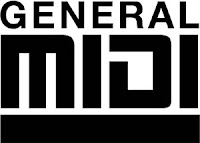

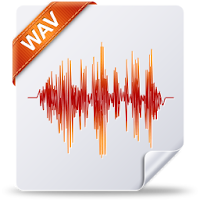
All Roland piano HP/LX models play back General MIDI song files
from a USB flashdrive which is a great feature and one I use quite often in my studio. The General MIDI/GS song format allows you to play your
piano parts live along “with the band or orchestra” in prerecorded MIDI songs and to interact with
multiple instruments (up to 16 tracks) at one time using well known piano lesson books
including thousands of popular songs from a variety of music styles and eras such as Jazz, Latin, Country, Rock, Gospel, Christian, movie themes, classical orchestra, pop, and much more which can be found on the Internet. Some of this music is free and some costs money. For more info on the General MIDI format go here: General MIDI and Playing Piano.
The MIDI song titles (and page numbers depending on the files) can be accessed and seen from the LCD user display screen on the piano which makes using it much more intuitive as compared to only having LED display screens or none at all. With Yamaha Clavinova CLP digital pianos for example, the only model that has the General MIDI song format is the top of the line CLP685 which is priced approx $6000. With Kawai digital pianos the only cabinet model with General MIDI playback format is priced at about $2500US which is good but unfortunately none of the better Kawai non-ensemble models above that one has the General MIDI song playback format. However, all of these new Roland pianos have this helpful and entertaining songplay and lesson learning format starting at under $3000US, so their models cover all the price ranges and cabinet styles. Roland has a number of other ways its pianos can record music and
play back songs for music education & learning that are quite useful
and can be important when trying to learn music whether you are a
beginner or professional. The recording and play back can be done as a 1-track audio WAV file which allows you to have an actual CD quality song that can be played on other devices such as your computer or converted to a MP3 audio file to play on an iPad, iPod, or iPhone. The pianos can also record 3-track MIDI so you can have separate right-hand, left-hand, and accompaniment tracks recorded individually and then played back as one song…it’s simple and fun to do. Typically most people only need or use 3 tracks of recording because you may want to hear your left hand piano part, your right hand piano part, and an orchestral accompaniment part. Some digital piano brands (like Yamaha) offer more than 3 tracks of recording in their models and up to 16-tracks of non General MIDI recording….which is nice to have but I find the extra recording tracks are seldom used by most people.
devices for musicians, teachers, and students for years who use them in their home
or studio (as I do) for more effective practice sessions. If you want
to know
more about this you are welcome to contact me.
All of the new Roland pianos offer the standard functions of layering two sounds together, splitting two sounds with one on the right hand and the other sound on the left hand, being able to play in a duet “twin piano” mode where two people can play at the same time by having 44-notes each playing the same octaves, and being able to transpose your live and/or recorded music to any key with a dedicated transpose button. The duet mode is good for teacher-student practice or for two family members practicing the same song at the same time…and you can do this all in privacy using headphones. One of the brand new features on the Roland pianos that Roland has never had on previous models is called registration memories and there is a control panel direct access button to access this function. In the past if you made some editing changes on the piano or set up some layers and split sounds, or wanted to change sounds within a song as you play it, you could not save them in memory for later recall. Saving them in “digital memory” would be especially useful for people who play in real time for events, for church, etc where you would likely be playing a variety of song sand want to set up each song a bit differently for sounds and features. rather than having to do these different setups “live” each time you played that song. The new registration memories allow you to pre-set these “registrations” or memories with the exact instrument sounds and functions you want to have and save them for later instant recall. This is a very useful feature and I certainly would be using it because I like to make changes to the sounds and functions (such as reverb amount, key touch, or instrument sounds) when I play different songs or even within the same song. With the new registration memories, of which there are 25 of them, this is now possible and I am very happy to see this new feature. You can even offload those setups to a USB flashdrive and store them in the flashdrive or on your computer if you feel these setups are important so they don’t get lost. This process would also allow to save more than 25 setup memories because you can offload as many as you want to. It is important to note that the registration memories do not save all features and functions on the piano, but they do save the primary features that most people would care about.
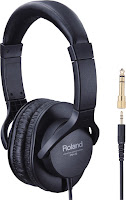
A lot of people use headphones when they are playing a digital piano for private practice so that other people in the room/house are not disturbed. This is obviously something you cannot do with a standard acoustic piano and therefore is a very big reason why people buy digital pianos…to play in privacy. Let’s face it, when someone in the house wants to practice their lesson or just wants to play for pleasure and there are other people in the home who are talking or watching TV, etc, it can cause a conflict. So using headphones for piano playing allows for more time playing the piano and if that can happen then I am all for it! On the new Roland pianos there is a special “3D effect” built into the piano headphone circuitry that will go through
stereo headphones which can make using headphones even more enjoyable. The 3D effect is supposed to give you the feeling the piano sound is all around you
coming from different directions. Roland calls it “an immersive sound
experience” which makes it seem like
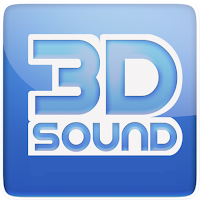
you’re not actually wearing
headphones at all…and that’s really the point of this feature. I tried
it out and found that overall, it had a natural effect and I believe most people will enjoy it. It actually
did sound like I wasn’t wearing headphones…although I was:). This is fairly new technology in digital pianos and it’s a nice feature to have
especially if you’ll be using headphones often. The 3D headphone sound effect
only works when the
ambiance button on the piano control panel is
selected and it can be turned on or off or controlled in incremental levels. Also, it’s important to
have/own good sounding stereo headphones for private playing
because you want to capture all the nuances of the new
enhanced Roland piano sound dynamics and tonal qualities and many low priced headphones don’t do that. You don’t need specific headphones to have that 3D effect but I can give you
some good
recommendations for quality stereo headphones if you don’t already have some.
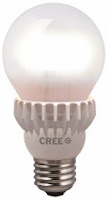 The speaker/audio system in each model is very impressive because Roland is using new audio technology not previously available on their pianos before. The best way for me to explain this is by referring to light bulbs. Most people know that saving electric energy and consuming less is the best way to go. The recent changes to light bulb technology now allows for a powerful bright light bulb which uses far less energy because of the new LED technology. So basically this means that instead of using 60 watts of power (per hour) to get 60 watts of light bulb brightness, the new LED bulbs use approx 14 watts of power to get 60 watts of brightness…and those new light bulbs last much longer because they are not using as much power as before. So when it comes to sound technology, it’s mostly all about wattage efficiency while offering good powerful volume (aka:decibel level) going through quality speakers and amplifiers that disperse the piano sound correctly and in a way that is most natural. Although having a lot of wattage power is not a bad thing in terms of achieving volume and sound fullness, that type of power method is using “old school” components at this point which are typically inefficient, more costly, and not as effective overall in many cases. It seems like many people want to go “green” these days so using less power and not having to replace components as often is a very good thing.
The speaker/audio system in each model is very impressive because Roland is using new audio technology not previously available on their pianos before. The best way for me to explain this is by referring to light bulbs. Most people know that saving electric energy and consuming less is the best way to go. The recent changes to light bulb technology now allows for a powerful bright light bulb which uses far less energy because of the new LED technology. So basically this means that instead of using 60 watts of power (per hour) to get 60 watts of light bulb brightness, the new LED bulbs use approx 14 watts of power to get 60 watts of brightness…and those new light bulbs last much longer because they are not using as much power as before. So when it comes to sound technology, it’s mostly all about wattage efficiency while offering good powerful volume (aka:decibel level) going through quality speakers and amplifiers that disperse the piano sound correctly and in a way that is most natural. Although having a lot of wattage power is not a bad thing in terms of achieving volume and sound fullness, that type of power method is using “old school” components at this point which are typically inefficient, more costly, and not as effective overall in many cases. It seems like many people want to go “green” these days so using less power and not having to replace components as often is a very good thing.
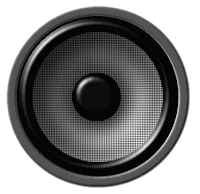

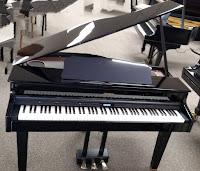 With this in mind, Roland calls their new sound technology “Acoustic Projection” starting with the new HP603 which has 60 watts of total audio power
With this in mind, Roland calls their new sound technology “Acoustic Projection” starting with the new HP603 which has 60 watts of total audio power
going into 2 amplifiers and 2 speakers while consuming only 9 watts of power (similar to my light-bulb analogy) and pushing out a maximum of 106dB of sound pressure (decibel audio volume). The HP605 has 74 watts of total
audio power going into 4 amplifiers and 6 speakers but consuming only 11 watts of power energy and pushing out a maximum of 109dB of sound pressure volume. The LX7 also has 74 watts of power going through 4 amplifiers and 6 speakers but four of those speakers (one large pair, 1 smaller pair) are housed in their own internal cabinets for each pair (aka: speaker boxes) within the piano and generate a bigger, richer sound with two near the top,
two near the keyboard, and two below pointing forward (instead of pointing down in the lower models). The LX7 consumes only 11 watts of power pushing out a maximum of 112dB of sound pressure power. I will say however that I was a bit disappointed in the LX7 bass frequency response because it could have been much better, deeper, and fuller and the previous model Roland HP508 was more to my liking in that way. The LX7 has plenty of volume, just not near as full sounding as a real upright or grand piano. The top of the line LX17 also has 74 watts of total power but that power is going through 6 amplifiers and 8 speakers with 2 of those speakers being large 10″ bass reflex speakers with dedicated amplifier power which makes that piano sound like a huge acoustic grand with impressive low end bass frequencies and power. The power consumption on the LX17 is only 13 watts pushing out a maximum of 112dB sound pressure volume, which is very loud if you really want it to be that way. The GP607 mini grand has one 8″ woofer in a separate
speaker box which is the largest speaker in that model. It also has 4
other speakers for a total of 5 speakers with 70 watts of power going
into 5 power amps at 113 db. In reality, the LX17 sounds much fuller and richer as compared to the GP607 and the GP607 is more closely associated with the LX7 with regard to sound output and bass response because the LX17 puts out much bigger bass frequencies than the new GP607 or LX7.
They (LX17 & GP607) are both loud enough to fill a big room, but volume is not the
issue. It’s the quality of the sound projecting from the piano cabinet
and speakers. The GP607 sells for $1000 less money in the US than the LX17, otherwise the 2 models are identical in every way except for cabinet design and speaker system. The GP607 looks great and is a nice compact size for a mini grand at 37″ deep. But the LX17 sounds much better than the GP607.
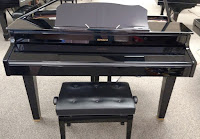
With regard to db *(decibal sound pressure), just to give you a sense of what dB’s translate to, a powersaw at 3′ away is approx 110dB’s of sound pressure volume and a loud rock concert is approx 115dB’s of volume. So when we’re talking 106dB to 113db in volume on Roland pianos, we’re talking about a lot of sound/volume power. These new internal audio systems give a more balanced
approach to recreating the acoustic piano playing experience in my opinion and it really makes these new pianos sound much more like they are natural acoustic pianos without speakers. When you look at previous model Roland pianos along with other popular brands, most people have been concerned almost exclusively with “audio power output” such as 40 watts, 60 watts, 100 watts, 150 watts, 200 watts, etc. But that is not necessarily a good reflection of actual maximum volume or quality of sound anymore. Think of that new LED light bulb along with new electronic products, new appliances, new cars, and other new consumer products that use energy. They are all moving towards efficiency in energy consumption while putting out more quality sound, more power with less consumption, better construction, more usable functions, and a variety of advanced features they never have had in the past. Roland has been in
the professional pro audio business for many years (I have owned and used some of their pro audio speakers) so they do have
experience in this area and it definitely shows in these new digital pianos.
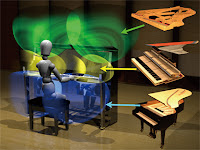
When it comes to sound, it’s all about what you hear because that is what counts in the end. So don’t let something like the new $7000 LX17 at 74 watts power output make it seem like it must not sound good or be as loud as a 300 watt output system that uses more energy. A good example of this would be the new Yamaha CLP685 top of the line model vs the Roland LX17 top of the line model. The Yamaha puts out 300 watts of total power going through 6 speakers and consumes 60 watts of power for that effort. The power output of the Yamaha digital piano is almost 2.5 times as much as the Roland, but it uses over 4.5 times as much energy to do so. However, the LX17 has 8 speakers as opposed to 6 speakers in the Yamaha and largest Yamaha speaker in that model is a little over 6.25″ vs the largest Roland speakers in the LX17 at 10″ each. The huge bass response in the Roland along with 2 additional speakers with all speakers laid out in the cabinet in a unique way actually gives the Roland sound system a big advantage in volume and sound quality in my opinion while using a lot less energy doing so. When I played the LX17, the internal sound system was a pretty incredible listening experience (like a big grand piano) and not one I have had on any other new vertical digital piano before even at 3 times the wattage power output. My best guess is that the other brands will need to play “catch up” with this new Roland sound technology but I am assuming that one day they will. But for now…it’s clearly Roland who is at the top when it comes to these internal speaker systems.
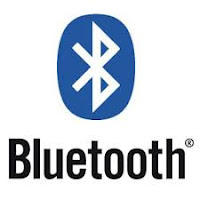
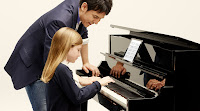
Another new technology now being put into these new Roland pianos is Bluetooth device connectivity. Bluetooth in digital pianos is relatively new and encompasses a number of separate features. So when you hear the word “Bluetooth” in digital pianos, it doesn’t mean they all do the same thing or can do everything associated with the Bluetooth technology. With the exception of the HP603 (no BT audio), the Roland Bluetooth functions offer a three different uses including BT audio streaming so that you can hear the sound from your Bluetooth capable external device (tablet, cell phone, computer, etc) come through the piano speaker system. Another Bluetooth feature is MIDI streaming connectivity so that you can interact with Bluetooth capable apps or programs such as Garage Band for iPad which is a great MIDI music and recording app. It is very popular for music education and lots of fun to use. So not only will the app respond to your Bluetooth input from the piano as you play the keys, but you can also hear the music audio coming from that app through the piano speakers. A third Bluetooth function is “pedal Air page tuning. This BT feature allows you to open up sheet music on your tablet with apps that have this “Air Page Turn feature so that you can download and read sheet music from your tablet and instantly turn the virtual pages by pressing a foot pedal on your piano exactly when you need to. One of those sheet music/page turning apps is called piaScore. With piaScore you can play thousands of songs from a free sheet music library through your tablet and turn the pages with Bluetooth page turner, and I previously mentioned. You can also import your own sheet music into the piaScore app so that you can have a custom library of songs that you can read directly from the app on your tablet device and be able to turn the sheet music pages with your Roland foot pedal page turner. So when it comes to Bluetooth and using that technology, there are still many apps that have not set up Bluetooth MIDI and/or Bluetooth audio or page turning yet.
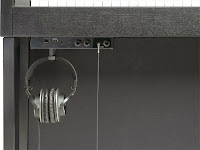
Speaking of connectivity, all of the Roland models have good connectivity to external devices with outputs and inputs including dual headphone jacks, stereo mini input audio jack to connect tablets, computers, iPod, etc to hear audio through the piano, two 1/4″ audio output jacks for stereo connectivity with external sound systems, USB flashdrive input, and USB output to device. This kind of connectivity is generally sufficient to meet most needs although all the jacks themselves are located under the left front of the pianos. This is fine for some connections but I would have much preferred to see the audio input and output jacks along with the USB output located on the back of the piano like most of the other brands do. It would be the more practical position for those connector jacks, but perhaps Roland had a reason for locating all of them up front underneath the piano…maybe it was less money for them to do it that way…but I don’t like it.
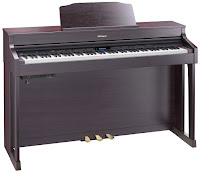
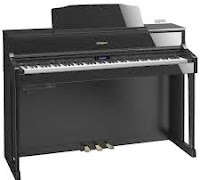 When it comes to the cabinet design of these digital pianos and digital pianos in general, the more they appear to look like pianos the better people seem to like it, and I would agree with that. So with regard to the appearance and size of these new models, I think Roland made them look better than ever and I like the way their new design as well as cabinet color choices, which I mentioned at the beginning of this review. The HP603 weighs in at 110 lbs measuring approx 55″ wide, 17″ deep, and 42″ tall with the music rack up. The HP605 weighs in at 120 lbs measuring approx 55″ wide, 17″ deep, and approx 44″ tall with the music rack up. The LX7 has a very unique cabinet design like no other digital piano cabinet I have seen before and this is a brand new look for a Roland piano. The LX7 has the most traditional piano cabinet of all in my opinion, but still looks contemporary and classy and I think a lot of people will like this one. It also is available in a color finish which no other brand in this price range offers and Roland has never offered in the past. That finish is called contemporary satin walnut and it is very attractive in my opinion and the wood grain in the LX7 cabinet has an elegant appearance with unusual grain direction and design. This is also true of the satin black finish as well. The LX7 weighs in at 170 lbs measuring approx 55″ wide,
When it comes to the cabinet design of these digital pianos and digital pianos in general, the more they appear to look like pianos the better people seem to like it, and I would agree with that. So with regard to the appearance and size of these new models, I think Roland made them look better than ever and I like the way their new design as well as cabinet color choices, which I mentioned at the beginning of this review. The HP603 weighs in at 110 lbs measuring approx 55″ wide, 17″ deep, and 42″ tall with the music rack up. The HP605 weighs in at 120 lbs measuring approx 55″ wide, 17″ deep, and approx 44″ tall with the music rack up. The LX7 has a very unique cabinet design like no other digital piano cabinet I have seen before and this is a brand new look for a Roland piano. The LX7 has the most traditional piano cabinet of all in my opinion, but still looks contemporary and classy and I think a lot of people will like this one. It also is available in a color finish which no other brand in this price range offers and Roland has never offered in the past. That finish is called contemporary satin walnut and it is very attractive in my opinion and the wood grain in the LX7 cabinet has an elegant appearance with unusual grain direction and design. This is also true of the satin black finish as well. The LX7 weighs in at 170 lbs measuring approx 55″ wide,
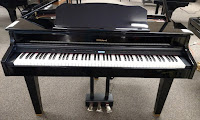
18″ deep, and 41″ tall. The music rack has two positions and can be adjusted slightly out from cabinet which is another unique feature. The top of the line upright style vertical piano LX17 has the tallest cabinet of any top of the line major brand digital piano that I know of. The LX17 weighs in at 193 lbs measuring 56″ wide, 19″ deep, and 45″ tall with the lid propped up (approx 42″ tall with the lid down). One of the unique features of the LX17 cabinet is that the top opens/props up at an angle and will stay up to allow piano sound to come up and out of the top of the piano like it would on a grand piano with the lid up. So not only does the LX17 have a beautiful cabinet design and finish, but this extra lid opening features also enhances the sound that you hear to make it more life-like. Neither Yamaha or Kawai has this cabinet feature on their digital pianos and it does make a difference…it’s not just for looks.
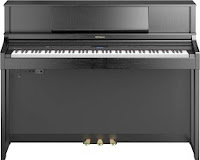
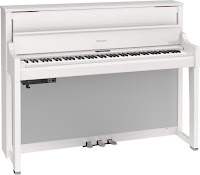
A few more unique features about the new cabinets is the new front lower (privacy) panel design. In past digital piano models the privacy panel was attached to the back of the piano pedalboard so that there was space (about 6″) between the back of the pedals themselves and the very back of the piano…which is not how real upright pianos are built. The full size privacy (aka: kick panel) panel on a regular upright piano is flush with the back of the pedals and therefore digital piano cabinets tend to look “fake” in this way as compared with real pianos. So this new “look” makes the all the Roland pianos very realistic in design and they look great (see left pics). Neither Yamaha or Kawai has this acoustic upright cabinet design feature, only Roland. Another new aspect of the Roland cabinet design is something the other major brands do not have. When you close the key cover on all these new Roland models (except for the LX17), there are 2 key cover positions that allow you to close the cover over the control panel buttons without covering the entire keyboard. It gives your piano a minimalistic look while you are playing the piano and yet the control buttons can be exposed to make changes to the functions if you want to do that. When you are through playing the piano then you simply slide the key cover the rest of the way out to cover up the keyboard. The LX17 has a traditional slow-close “fallboard” type key cover that pulls/falls down over the keys like on a grand piano. Although there is not the 2 position slide-out key cover on the LX17, the grand type fallboard key cover is still a very nice upgrade. When you cover the entire keyboard on any of the models the power automatically shuts off without you need to physically push a button or flip a switch. This feature is a definite power saver and is very convenient to have. When you are ready to play the piano then you just open up the key cover and the power automatically comes on without touching any buttons. Speaking of
buttons, the control panel buttons have been redesigned in their height position to offer a better, more tactile feel than on the previous models. This is a relatively small upgrade but a good one and is something I noticed right away when pressing the buttons to control features in the piano. Even the user display screen has been upgraded and slightly enlarged with more info displayed at one time in the HP603 and HP605 as compared with the previous HP504 & HP506, so that the screens are now the same size in all of the new models. It seems that Roland has thought of everything including these small little perks which I found quite fascinating. Little things can mean a lot over a period of time and no other major brand that I know of offers this kind of cabinet key cover autopower feature in their pianos.

I usually don’t talk about piano benches that come with the pianos because they are typically smaller and not out of the ordinary. However, all of the included Roland matching benches are duet size (available in the US) which can normally seat two people instead of just one and the bench also opens up for music storage inside. The GP607 has a single size height adjustable bench. Beyond that, the polished ebony, polished white, and satin walnut cabinets in the vertical models come with even larger and longer duet benches (only available in the US) as compared to the regular duet bench
with the other HP/LX cabinet finishes. These upgraded benches include upgraded hardware, materials, construction, and finishes. By themselves those benches would cost in excess of $200US each so they are not just an after-thought but are USA made custom benches. You may notice pictures of the Roland pianos on various web sites (including the Roland website) showing small adjustable benches. The adjustable benches are not available in the US and do not come with the pianos. Along with each bench Roland also includes a very useful and upgraded
accessory kit valued at approx $400US. The free accessory kit includes $150 Roland RH-A7 stereo headphones, a clip-on or stand alone LED piano light with batteries, a digital
instruction book that’s compatible with smartphones or tablets, two
songbooks, interactive music apps, free interactive downloads, and more. There are no top name digital piano manufacturers that I know of who includes all these accessories with a digital piano purchase. Sometimes I see a few stores offer some accessories but those accessories typically are not near as good or as extensive as this package is. So even in this way Roland is trying to come out on top.

Finally, last but definitely not least, the Roland company has just introduced a new warranty on all of the new models that no other manufacturer comes close to. Believe it or not, the warranty has gone from 5 year parts/2 years labor with in-home service on previous models, to a gigantic 10-year parts/10 years labor with in-home service on these new models. That’s a very big and unexpected increase in warranty time coverage and is now the longest by far in the digital piano industry. I will admit that based on all my experience with Roland digital pianos as well as with later model Yamaha & Kawai digital pianos, I have seen relatively little breakdown or electronic issues with these brands over a 10 year period of ownership given that the owner treated the piano with care. So typically a good digital piano should not need service over a long period of time…but I believe it’s certainly a good thing to know, that for no extra charge, the piano will be protected against manufacturer product defects for 10 full years.
| HP603 satin rosewood |
In the final analysis I believe Roland has finally hit the “sweet spot” in its quest for a great line of digital pianos with these models by producing instruments that focus on recreating a more authentic piano playing experience first and foremost along with incorporating this new technology in attractive well built cabinets at price points which are affordable, especially compared to some other digital piano brands and regular new acoustic pianos. Even though the HP603, HP605, LX7, and LX17 have some very nice digital functions and lots of extra instrument sounds along with a few fun and educational features, these new models seem to really focus on that all important piano playing experience…and for me that’s what is most important, especially in this higher price range above the less expensive internet pianos that are out there under $2000US. The Roland pianos have no drum patterns, no auto-accompaniment interactive chords, no large color touch display screens, and no digital voice commands built in. However, Roland does have an intuitive iOS app for iPad which can control some of the features of the piano on the iPad color touch screen. The app also allows for new new interactive musical features to be used along with the piano which makes playing these Roland HP & LX models even more fun. The name of that app is called Piano Partner 2. But without using the Roland app, these pianos are mainly for people wanting to play music and focus on a satisfying piano playing experience and these instruments can definitely do that. These pianos are only found at local Roland authorized piano stores in the US and are not available for purchase over the internet in the US.
| HP 603 closed key cover |
The LX17 upright model has especially become popular for the Roland company since they came out in the marketplace, although it is in a higher price range. The LX17 is really a nice piano for the price and if you have the budget then the LX17 would be my choice over the other Roland models, but it’s good to know that you can get the same key action, piano sound chip, and pedaling on any of these Roland models. In fact when using a good pair of stereo headphones, all the models are identical and sound the same. That means if you don’t need to fill up a large
space in a room with big sound through the internal speakers, or you don’t need the upgraded cabinets such as the HP605 (left pic with closed key cover), LX7 or LX17, or perhaps you’ll be using headphones most of the time, the HP603 may be sufficient for your piano playing needs without the extra expense of the other models….although the HP605, LX7, and LX17 certainly are nicer in many ways. Do yourself a big favor, before you make a buying decision on a new digital piano between near $3000-$7000US, do your homework and be sure to have explored all the options because you want to do this right in the first place because generally once you make a purchase in this price range it’s likely going to be a piano you keep for many years. I know that people have different musical expectations and tastes when it comes to playing and listening to piano music, and you could likely be happy with a variety of models and brands in this price range. Nevertheless, these Roland pianos are very good instruments in terms of an overall piano playing experience, although I also like the some of the new Yamaha Clavinova & Casio Grand Hybrid digital pianos in similar price ranges.
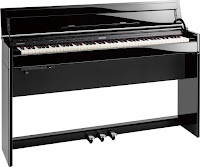 |
| DP603 |
The Roland company also has another piano model for a bit less money called the DP603. The DP603 is a contemporary compact furniture cabinet version of the HP603A, and for less money at $2399US internet price (satin finish) and $3199 (polished finish). It comes in 3 different cabinet finishes and may be a good option for someone who wants to be in a lower price range and likes DP603 cabinet style. It actually has the same piano and control panel features as the more traditional cabinet HP603 and even has the same key action and physical modeling technology. I do like this piano and it may fit a person’s need better depending on your musical and cabinet needs. Go to the following link to read my new DP603 review and be sure to contact me before you buy it from anyone. I can tell you how to save even more money on Roland pianos. Roland DP603 Review
Another impressive line of digital pianos that recently came out this year is the new Yamaha CSP150 and CSP170. These new models are offered in different cabinet finishes including matte black at $3499US for the CSP150 and $4699US for the CSP170. They also come in an elegant polished ebony finish with the CSP150 at $3999US and the CSP170 polished ebony at $5299US internet discount price. What makes these new models so exciting in my opinion is that they are the 1st home digital pianos ever to be controlled by a proprietary Yamaha app called Smart Pianist designed for iOS iPad and Android tablets. Doing it this way allows
the user to get way more impressive and useful features and functions than any other digital piano brand and model out there and without loading up the piano with lots of unnecessary buttons and built-in display screens. In other words, these pianos play and look like a real acoustic piano only having 2 buttons on them and a volume control. But because they are controlled by a tablet with an intuitive proprietary app designed by Yamaha & Apple, your “interface” is your color touch screen on your tablet device using the familiar controls of your tablet to access all features off the app and allows the piano to play in a way you never thought possible. Also, being able to put all functions and features in an easy to use app accessed from your tablet touch screen helps eliminate the obsolescence that is normally found in the other digital pianos in this price range because the app is updateable and upgradeable unlike proprietary hardware driven digital pianos.
Finally, a new up & coming digital piano brand to consider around the Roland price range that is now available in the US is the new all Italian designed & made Dexibell VIVO H7 & H3 digital home pianos. Dexibell is a company you have likely never heard of but it is fairly well known in Europe and can be compared in sound & playing quality, build quality, and piano authenticity to what a Ferrari might be thought of in the world of fine automobiles. Dexibell has some of the top digital piano technology designers in the world who work for the company so they do have years of experience with this kind of product. I have played these new pianos many times and they really are impressive in reproducing a very natural piano playing experience using a combination of sophisticated digital sound sampling combined with cutting edge physical modeling technology and even advanced pianists will appreciate the results of what these pianos can do.
If you want more info on new digital pianos and LOWER PRICES than internet discounts, please email me at tim@azpianowholesale.com or call direct at 602-571-1864.






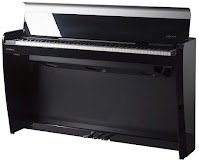










One of the coolest features of the LX-17 is this:
http://www.roland.com/products/piano_designer/
"Inside the instrument are many parameters that allow you to finely adjust the sound elements of the piano, much in the same way that an experienced piano technician fine-tunes an acoustic piano for a particular artist or musical style. With the Piano Designer app, you can easily control these many elements from the graphical touchscreen on your mobile device. In addition, the app includes many ready-to-play settings, allowing you to enjoy custom sounds created by world-class piano technicians."
I want to buy the LX-17 but, as you say, no one has one to sell. Another problem is that they are only sold in certain piano stores — I asked my local music store, which is a Roland dealer, if they could get one and they could not, as they are not a piano store. So it looks like I'll have to travel out of state to buy one (when it becomes available) since there is not a single such Roland-authorized store in mine.
They're definitely making it very difficult to buy one.
I just got a Lx-17 here in UK on Dec 22nd. Amazing piano. Beautiful piece of furniture as well. Im glad I got this and not the CLP585. The bluetooth is a winner and the sound! well…
I received my LX-7 this week here in Germany after ordering last week. The candidates were that and the CA-97, CLP-585 and GP-500. I made my decision after testing the available DP's at the local dealer which were the HP-603, CA-67, CLP-575 and GP-300. While I liked the GP-300's action, sound and expression (after adjusting decay) the Roland I liked best for the overall package and the expression. With the better sound system the LX-7 might come closer to the GP-300 I tested in the shop.
I would like to say thank you for your review and the detailed description of the Rolands and helped my decision.
Oh my god @。@ I wish someone in my country could make such a detailed and pro kind of guide like this.
I think I'll buy hp605
I'm seriously thinking about getting a HP603, would it make a better virtual piano controller than the VCP1 due to its 4 sensors keys?
I never said that the Roland has 4 key sensors. It is a 4-part key sensor system which includes 3 key sensors and a processor circuit board under the keybed which gives the 3 sensors per key a boost in processing key data.
Hi,
Would you recommend Kawai CA67 or Roland HP603 for a professional musician who plays mostly classical music?
Thank you!
although you could probably be happy with either piano as they are both great products, I feel that the piano tone and pedaling on the Roland offers a more complex organic tonal experience for both piano sound & pedaling sustain. The key actions are different on each one and they both are satisfying to play. I personally like the user interface control panel on the Roland over the Kawai because of where the buttons are located.
What a great, very detailed to read review. After reading al lot of reviews and listening on youtube I was in doubt between the Yamaha P585 and the Roland LX series. Yesterday I played on the Roland LX-7 and LX-17 and the Yamaha. Accept from the sound quality (that's could maybe also be a matter of taste) there really is a lot of difference in the way those piano's feel and play. The Roland does feel more 'alive' and that seems to heavy a big impact on the way I play and experience the sound as being more natural. Your review explains very clearly why it feels this way and it confinced that I am going to make the right choice. The only thing I noticed is that the LX 7 seems to have a brighter sound. Is this because the speakers in the LX 17 make the overall sound more bombastic?
I can tell you how to get a fuller, bigger, bassier sound on the LX7 if you email me directly.
Can you describe in greater detail the difference in key action?
Even though I wasn't looking for a furniture model, I gave the HP605 a try in a shop the other day, and… am I impressed!
Now to my surprise I can't find a single portable/stage piano with the PHA-50 key action on Roland's website.
I wonder if offering such a model would make sense for them (technically and economically).
it will be awhile until this new key action is put into a higher priced Roland portable model. It does make a lot of sense to have it and in the future you will see it
I have purchased hp 603. My local distributor has only hp 603 and lx 17 .my daughter liked this piano so much especially the key action. We have upgraded from Yamaha Dgx 640. We found great difference between the the two pianos. My daughter told me that the key action of hp 603 is closer to grand piano than Yamaha clip 545 . She has tried both in the shop. Now the problem is to sell our Yamaha Dgx 640 especially ther is two newer model 650 and 660 🙂
After using hp 603 for months I and my daughter found it great but we need rhythms in the piano like our previous one . Rhythms help so much learning new pieces. But key touch and sound of hp 603 made my son wants learning piano.
after upgrading the operating system of hp 603 and downloading piano partner2 on iPad rhythms are now available . now I can also see the note sheets of the songs in internal memory .
Hi, Thanks for the great detailed review. I spent quite a long time selecting an instrument and finally went for the Roland HP603 January and have been very happy with it so far.
Unfortunately I've found a strange and surprising problem. One that is quite incredible to find on a Premium product in this price range. I'd be interested to hear if others can reproduce this.
On a piano, If you press a key briefly, the sound should be brief and cut off the moment you release the key. If you hold down the sustain pedal the note should continue to sound and decay gradually.
Now on the 603, All the keys from the bottom of the piano up to F6 work as expected.
But all the keys from G6 up play as if the sustain pedal was pressed.
I.e. The sustain pedal is no effect on the notes G6 and above. Because they already sustain.
To demonstrate this I created a short video clip.
https://youtu.be/2Q7A33LyQgk
I wondered if this is a defect with my piano or a general software issue, so I visited a Roland dealer in Prague to try another piano. The dealer had only a stage piano, but it was a model that also uses the same SuperNatural sound engine as in the HP603.
To my surprise, and that of the dealer, the problem was there too.
This would seem to indicate that the problem may be present on all Roland Pianos with the SuperNatural engine.
A few more observations.
On the HP603 The problem is present on all piano sounds.
It is not present however on any other sound, at least on the 20 or so that I tried.
I had firmware version 1.03 on the piano, so I upgraded it to 1.05.
This has not solved the problem.
I have reported this to the dealer where I bought the piano so hopefully Roland will respond with a new firmware patch that fixes this.
It is really quite shocking for a premium product like this to have such a serious problem.
I'll let you all know the outcome.
What you are experiencing with your Roland piano is NORMAL for ALL acoustic pianos and therefore is reproduced on all digital pianos. Regular acoustic pianos do not have dampers on those higher notes and they are allowed to naturally sustain for many reasons and pianos are designed in that way. It allows for more natural sympathetic vibrations, pedal resonance, and other naturally occurring tones because those higher notes can sustain all the time, although the sustain time is relatively short. Go look at some regular acoustic pianos in your area and you can hear them do the same thing….therefore there is no problem, you can withdraw your report, and not be shocked anymore. I would also apologize to Roland and the dealer for the fact that it would appear you did not actually investigate this issue by looking at and listening to regular pianos for a comparison. Then you would have realized that what you are experiencing is normal:). I wish you musical happiness.
By the way… If your piano dealer did not know this sustain issue/situation was normal on those keys/notes then he should go to piano school to learn more about regular acoustic pianos and how they actually work….or maybe just go look at and play any acoustic grand or upright piano. Or "Google" it
yes, this new app is very nice
Hi Tim,
I just bought the LX7 and would also like to know how to get a fuller sound. I appreciate the information whenever you can provide it. Thanks
Larry
Email: ylarry363@gmail.com
Agreed… I encountered this with my new HP605, although I was prepared for the (1) being someone lost with 88 keys from a 64 key piano, (2) the REAL sustain power; there's a difference when you actually play and experience those sounds and feel. Now it's not just playing but learning to use/play a piano… 1/4, 1/2, full pedal… etc. 🙂 What would be nice maybe in future firmware is a setting to just keep the sustain on at whatever level you feel is right for your playing style.
I've recently purchased the HP-605. Awesome piano, but found the same issue as described in the review with the damper pedal (sustain). At full pedal, the resonance literally kills notes afterwards it's so powerful, some tweaks can reduce the effect but the only real solution I found was to adjust the key weight to 30 (from 50) and then use 1/4 to 1/2 pedal. 🙂 Of course these are new learning curves if you come off a lower digital piano to a class like this that behaves like a real one. 🙂
Hi Tim,
Thank you very much for this very extensive and clear review. This really helps. I am doubting between buying a Roland HP-605 or a Kawai CA 7 / CS 8. I read you are testing the Kawais at this moment. Can you already provide some advise (especially on the key action and the expressiveness and quality of the sound)? Can you already give any indication on when the review of the Kawais will be published (as I so much love your reviews). Thank you!
Thanks for the very thorough review. Two months ago our church just bought the LX17 for our basement choir room practice piano, and to be used occasionally in worship such as in the gym, which we did tonight. So far I have loved the piano… except tonight during a worship song, the piano shut itself off while I was playing it, twice! I had to use the power button to get it back on. It had not done this in two previous services. It seems like it might be a problem with the automatic power down function of the fallboard, which also serves as the music stand. Later one of the other band members and I were checking it out (with no music on the fallboard this time) and it powered down several times again. It would come back when we moved the open fallboard just a little bit. Anyone else have this problem? I will be calling a technician first thing tomorrow….! Thanks- Senja
Hi Tim,
Thank you so much for this comprehensive review on Roland digital pianos. I am a father of a boy and a girl and I want to send them to learn playing piano as other Asian parents do. I am interested in HP 603/605 for the reason of no need for tuning or special care, and it doesn’t disturb neighbourhood if kids practise frequently. I guess ipad apps is a bonus too. However as we lack of musical background, we hear from most other parents in Asian community that acoustic piano is the only way for kids to learn piano correctly. Popular selection for acoustic piano here is dealer refurbished Yamaha U1 or U3, which is twice expensive than HP 603 but less than half price of new acoustic upright. Sorry for the long background story-telling, my question is, if we go for HP 603, will the choice make my kids disadvantaged to learn playing piano correctly on the road of pratising for piano exams? As there is difference on keyboard feeling, pedalling and sound quality between HP 603 and U1. Unfortunately Asian parents normally use piano exam grade to measure the progress of kids learning piano. Please help, thanks in advance!
That is really weird! I have not heard of that happening before on any new Roland piano. Call the dealer you bought it from and see what they can do for you. Also, just to be sure, is possible your piano is set to the "auto-off" function which means the factory default setting of the piano is set to "on" which means the piano will automatically shut off after not using the piano for 30 minutes. I know you said it did it while you were playing, but turn the auto-off function to off just to be sure. You can check this feature in the "function mode." But it is likely this could also have to do with the LX17 key cover being out of alignment or a faulty sensor? Your dealer can also talk with Roland to see what they might know about this.
I have a similar problem like J. Senja Morgan my hp 603 makes restart with himself in random way
Thanks for your help… great suggestions! It was unnerving to be playing/singing in a live setting and suddenly realize that the sound had quit! Thankfully I wasn't the main lead instrument at the time, and I think I was the only one who noticed. I will for sure look into disabling the "auto-off" function while we wait for help from the dealer and/or Roland. It is such a new piano that I hadn't realized yet that you could disable that (annoying) feature. Hopefully we will be able to get this problem fixed before next Wednesday's worship service! Thanks again~Senja
Hi,
Has anyone noticed with the HP605 after C6 that A, B, B#, C have a "twang" sound to the notes when sustaining. Individually they sound normal, but when using the pedal with lower staff sustain it sounds like the notes are being washed by a title wave, and strangely enough I get cleaner sound with a pair of Sony headphones.
Anyone have any thoughts on this?
would you please tell what happened with your problem . I have the same problem with my piano hp 603 and I don't know what to do . thank you
Hi Tim,
Thank you for your thorough and insightful review into these digital pianos (and, indeed, all digital pianos!).
I am struggling to choose between the HP 603 and the 605. My budget is tight and I am wondering whether improvement in sound due to the 6 speakers is worth the increase in price.
I am not too concerned by the lack of BT audio in the HP 603 as I am happy to use a line in cable for that instead.
Thank you!
try turning off the key cover auto power on/off mode to "off" or "defeat" in the function editing system.
the factory defaults for the "piano designer" mode may not be to your liking so go into the "piano designer" editing mode, find the string resonance and pedal resonance settings and reduce the amount of resonance for both of those features to a low amount such as +1 or +2, or even turn them off completely and that should help resolve the issue you are experiencing.
there is a noticeable difference between those 2 models with regard to the fullness, bassiness, and loudness of the piano sound. Unless you are willing to add external monitors to the HP603 to enhance the sound, the HP605 would be the better choice and that's the one I'd recommend if it fits within your budget. You can email me direct if you have more questions.
Tim, can you tell me, are the audio outputs on these pianos balanced, or unbalanced, or both? Thanks!
typically consumer digital pianos like these new models have unbalanced audio outputs but I do not know about the new Roland pianos for sure in that way. I can always find out:)
Hi Tim,
Two questions. Are the DP603 and HP603 comparable? Also what are the main differences between DP603 and DP90. Thank you for such a great article.
The DP603 is a compact cabinet version of the HP603. However, the DP603 offers a bit more than the HP603 in terms of it having Bluetooth audio streaming and a higher db sound level. The DP603 satin finish does not automatically come with a bench whereas the polished finishes do come with a matching bench. However, the HP603 has a much longer factory warranty (10 years) and comes with additional upgraded Roland accessories as I mentioned in my review, whereas the DP603 does not. Otherwise they are both identical and play the same. Obviously there is a price difference in that the DP603 is less money and its cabinet design is not traditional like the HP603. I hope this info helps and if you are in the US I can tell you where you can purchase the new DP603 for less money than internet price if you are interested in that model. As for a DP90, there is a DP90 but that model is quite old. However there is a NEW FP90 which is a portable stage type version of the DP603. Maybe that is what you are referring to?
Hi Tim,
Thank you for such a comprehensive review. Would you give the same recommendation for the DP603 as the HP603? Thank you.
CM
Good evening. I'm interested in buying a HP 605 or a Yamaha CLP 545. Could you compare those models for me? Which one suits better someone who is looking for an acoustic piano experience?
Good evening. I'm interested in buying a HP 605 or a Yamaha CLP 545. Could you compare those models for me? Which one is better for someone who searches an acoustic piano experience?
Hi tim,
I have purchased Roland HP603, and in general, I like it very much. However, I feel the keyboard a bit noisy, what I don´t notice when I play it at the store. What do you think about that?? How is it compared to the NWX Yamaha action??
Thanks
the Roland HP603 and the other Roland pianos actually have one the quietest key actions available on any digital piano. It is not noisy by normal standards and in fact real acoustic piano key actions are much noisier. The issue is that when real pianos play they are very loud and you cannot hear the key action noise. On a digital piano you can turn down the volume and when you do that then the key movement will become more noticeable. But as for Roland being loud or noisy, it is definitely NOT noisy as compared to most other key actions in the top name brands. You'll just need to get used to it and consider it normal.
'there is a noticeable difference between those 2 models (603 and 605) with regard to the fullness, bassiness, and loudness of the piano sound.'
But do you know how this is accomplished? From what I read the extra speakers can't have anything to do with that. The main two speakers on the 605 are 30 watt speakers, just like the 603 has. Or are they different quality speakers? Or does the bigger cabinet size result in the changes you mention in the quote?
I have a relatively small living room with neighboors surrounding me, so it's not likely i will ever play at (near) max volume, so it is difficult deciding if the 605 still has added value for me for the extra 500 euros it costs.
hi
i have hp 603 . recently i noticed that the damper pedal is very light at first and has no effect and suddenly i feel the resistance and hear the effect of the pedal . i do not know if this normal or not . would you please tell me if this normal or not . thank you
Hi Tim, I've just started taking piano classes but I'm really committed to it. I tries HP 603 and HP605 in a store but actually preferred HP 603 as the sound seemed to come "directly" to me…is that possible? They didn't have LX7 but I tried LX17, which of course I found amazing…given the price, was thinking that it might make sense to buy 603 (or 605) and later on, if a feel the need, I could buy a natural piano as it seems to be a consensus that it is always better…what do you think?
Hi Tim:
Do you think the key action of the Roland FP90 is similar to that of the Roland HP603 or HP605? Since I do not like piano key action that is stiff and heavy, do you think I should purchase the Roland FP90 over the Kawai ES8 since you did mention that the key action of the Kawai ES8 is a bit more heavy.
Thank you.
Patrick
Last mont, I replaced my Roland LX10F with the LX17. Couldn´t be happier. It's a completely different experience. The LX17 is more engaging to play than the LX10F, much more organic, as you said, and it is so much easier to go from pianissimo to fortissimo. The dynamics are really really good. I have also tried the Casio GP500. Though I liked the key action, I think it's not better than the action of the LX17, just a little bit different. And regarding the sound quality, I much prefer LX17. Casio samples just felt a bit "plastic" for me. It is a matter of taste, of course, because both are incredibly well built digital pianos. Dario.
Hello Tim, thanks a lot for your amazing work ! I bought my LX-17 last week and I have already noticed that problem several times though I've installed the last version of the system (1.11) and disabled the auto-off function after x minutes AND even the shutdown by closing the cover… I'm french, please forgive my poor english ! Regards !
Your Review on Roland HP603, HP605, LX7, LX17, GP607 Digital Pianos:
This is the most thorough, accurate, well-informed and readable review I have ever read, about anything. Excellent job Tim.
This is the most thorough, accurate, well-informed and readable review I have ever read, about anything. Excellent job Tim.
This comment has been removed by the author.
Hi all. Thanks for this review; after reading it and other ones, I went for testing some avaiable models in a shop (thinking about Yamaha Clavinova 645), I decided for a Roland GP607. I am fully satisfied by such a mini gran piano. A fantastic keyboard, much better than others digital pianos. An excellent sound, both from speakers and headphone. Greetings from Italy.
Great review of the Roland upright LX17 — thanks! I bought one about a month ago and love everything about it except the music rack (created when you raise the key cover). There's no problem when I improvise (obviously) or play from music books, but it's almost impossible for individual sheet music to stay in place on the rack because there's not a solid back that's attached to the rack itself. I've taken to placing sheets of cardboard behind my sheet music to give it something to rest against… not the best look for such a beautiful cabinet! Any suggestions? Thanks, Tim!
Hi, have you had a chance to review the bigger GP609? How would you say it modifies your comments on the GP607?
I have played the GP609 5' grand version of the GP607. It is exactly the same piano except with an obviously bigger, more "grand-like" cabinet and larger, more powerful internal speaker system. It sounds big, bold, and bassey so if that cabinet size and price range (approx $11000) fits your needs and budget, then it would be a good choice.